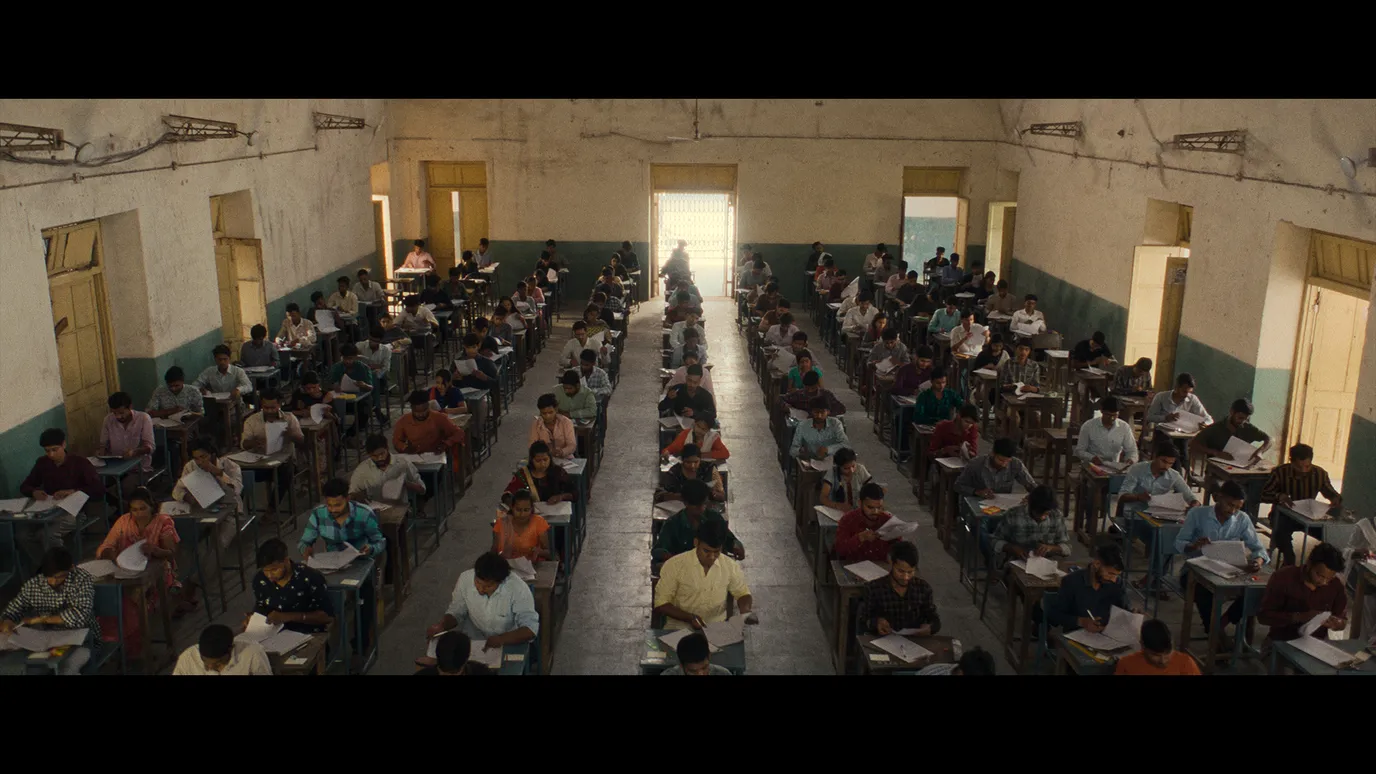All India Rank (2023) Movie Review: As our protagonist, seventeen-year-old Vivek Singh (Bodhisattva Sharma), plugged his headphones into his Walkman aboard the Avadh Express from Lucknow to Kota, and the cassette tape played the extremely catchy, eighties disco-era reminiscent melody of the song ‘Noodle Sa Dil’ in the vocals of Aditi Paul, the real and tangible world around Vivek disappeared to give way to animated titles.
Right at the outset, director Varun Grover – in his debut feature film All India Rank – sets out the rules of his visual grammar and how it will operate on screen. In his world, the real and surreal are fluid counterparts complementing each other. The inner, expansive, and imaginative world that Vivek inhabits in his mind is as much part of the actual world as the real world is part of Vivek’s imagination. There are no defined boundaries where the real ends, the surreal begins, and vice versa.
The seamless blending of the real and the surreal, coupled with the film being a nostalgic time capsule of an era gone by – the film is essentially a coming-of-age narrative set in the growing, post-liberalised India of the nineties, a time which seems like a distant memory now – reminded me of Michel Gondry’s 2008 comedy, Be Kind Rewind. Gondry, with his ability to traverse between fact and fiction, the conscious and the subconscious in his films, is a reference point for Grover in his debut feature.
More particularly, Be Kind Rewind follows two friends at a VHS rental store as they attempt to recreate films that have been forever erased and, in the process, find joy and meaning in their own creations. Similarly, All India Rank’s glance back at the era that won’t return becomes a catalyst for some bittersweet lessons to remember for Vivek, as well as post-liberal India as a whole.
A semi-autobiographical film – Grover himself is an IIT-BHU alumni – All India Rank charts Vivek’s journey as he’s shipped away from his hometown Lucknow and his extremely protected middle-class upbringing to Kota – the city that’s become synonymous with preparing thousands of young and impressionable minds for IITs through coaching classes and institutes. Even though similar in subject matter to projects from the TVF stable that have explored the lives of students whose existence revolve around coaching classes, whether it is the UPSC exams (Aspirants) or IIT (Kota Factory), Grover’s treatment, tone, and what he wants his audience to take away from his film is what makes All India Rank stand out.
When you look at Aspirants or Kota Factory, for example, you get the feeling that it’s an adult’s voice – someone with the benefit of lived experience and hindsight – looking back at their adolescent past. Whatever that is yet to unfold in the episodes to come has already happened. It’s the older version of you writing a letter to your younger self, letting them know that there is no need to worry. Everything did, in fact, go according to plan, even if it didn’t seem like it at the time. Lessons are obvious. There are no rough edges. Everything is neat and tidy. There is no sense of discovery or possibility because what’s been shown feels like a re-enactment, a recollection of memories past.
All India Rank isn’t like that. When you hear Vivek’s inner monologues as the film’s narrator, Grover is careful and precise to frame them as an adolescent speaking in the present tense. We partake in Vivek’s feelings of uncertainty about his future, the anxiety of being unsure of his own capabilities and desires, and the burden of expectations that he carries. There is a sense of wonder in how this unfolds. No one knows what lies ahead, least of all Vivek. These mixed feelings – of uncertainty, excitement, possibility, and fear – all intertwined with each other come across as a more realistic and true-to-life look back at the process of discovering yourself as an adolescent.
One aspect that works in favor of this style of framing is Vivek’s characterization. For the outside world, he comes across as a passive protagonist – he doesn’t know what he wants because he’s still discovering himself. Fellow coaching friends Chandan (Neeraj), Rinku (Ayush Pandey), and his crush Sarika (Samta Sudiksha) – all of them seem to have an idea of the rank they’re aiming to get or what they want to achieve while spending their time in Kota. Vivek is there with them, mostly because, according to his father, RK Singh (Shashi Bhushan), “IIT ka ladka, Bermuda chappal mein bhi sabhya dikhta hai” (A student from IIT looks civilized even in boxers and slippers). Vivek doesn’t support this notion but isn’t particularly against it either. At the crossroads where he finds himself, he just doesn’t know anything for sure.
You might think that having a passive lead protagonist – things happen to or around Vivek; he rarely takes the initiative – might be a problem. A protagonist who doesn’t know what he wants. Surely, that’s against conventional screenwriting wisdom. But, as we’ve seen in other films like Saim Sadiq’s Joyland (2022), for example (see the largely passive protagonist Haider in that film), a passive protagonist is no barrier to building an engaging narrative. What’s even more important here is that Vivek just appears passive to everyone else, but his inner world is dynamic, thanks to an active imagination and flights of fancy. This inner world comes to life for the viewer in an animated form, led by exceptional work from Allen Shaw and Siddharth Kaneria.

The film wants us all to be a little more like Vivek and question our so-called certainties and accepted beliefs about how the world operates. The lesson, as we discover, is not for Vivek to become more certain about his future but for all of us to be more curious about ours. All of us need to do a little bit of ‘growing up.’ The way this is revealed is through subtle nods and nudges scattered throughout the film, with ample doses of wit and black humor. For example, Vivek is expected to show ‘discipline and control’ to crack the IIT, and yet, it’s this very discipline in one’s personal life that’s lacking in both his mother (Geeta Agrawal) and father.
His mother cannot resist eating sweets despite having high cholesterol issues, and his father is a chain smoker who goes around lecturing strangers not to smoke in front of his adolescent son as it would be a bad influence. From the inability to utter the word ‘sex’ out loud, showing the extent of how repressed Indian society is, to speaking out against using language as a form of othering, Grover takes this opportunity to highlight exactly how much growing up we need to do.
In the film, Grover also highlights a more subtle but no less dangerous form of patriarchy through the characterization of RK Singh, Vivek’s father. This is not the ‘in-your-face’ kind of patriarchal character whose target is women – the kind of obvious and easy stereotype that we’ve come to see time and again in mainstream Hindi cinema. The toxicity has a lot many layers to it, one of which isn’t readily obvious.
RK Singh is a model government employee – he never talks back to his superiors, is hungry for validation at work, and is a caring husband to his wife. Unable to stand up to bullies who mock him at work and in his personal life regarding an incident with his wife, he takes out all his frustration on his son, Vivek. The only person Singh feels he has power over is his son. And he exercises that at every opportunity to feel like a ‘man.’
What also brought a huge smile to my face was the specificity in the use of language. It was honey to my ears to hear pet Lucknawi phrases littered throughout the film, grounding the authenticity of the narrative. It was also a pleasant surprise to see Lucknow-based artist and dastango Himanshu Bajpai in a small but noticeable cameo.
Ever since Anurag Kashyap’s Gangs of Wasseypur (2012) gave a new language to what a film set in Eastern-Uttar Pradesh and Bihar region could sound like on screen, many subsequent Hindi films that set in the Uttar Pradesh region have made the mistake of treating the state like a monolith in terms of language and dialect specificity. It’s not enough to say that your character is from Uttar Pradesh, for someone from Lucknow does not speak the same way as someone from Gorakhpur. Much to my delight, All India Rank gets this linguistic and geographical specificity spot on.
The original music for the film by composer duo Mayukh-Mainak is distinctive, and the very particular sound of north Bengal folk music – something which hasn’t been heard before in Hindi films – lingers with you until long after the credits roll. Most of the songs are also not lip-synced. ‘Noodle Sa Dil’ has a retro feel, and the ‘Competition’ song sung by Shahid Mallya contextualizes the rat race that is the IIT entrance exams. However, my favorite song is the one that highlights that everything is always perfect in books, but that isn’t the case in real life. Grover, an accomplished lyricist, has used songs to convey little nuggets of wisdom that are in line with the film’s sensibility and playful tone.
In terms of performances, Bodhisattva Sharma had a tricky tightrope to walk – remaining passive on the outside and yet convincingly conveying that he’s hiding an exciting inner world that no one’s aware of. Samta Sudiksha stands out in her performance as Sarika, especially as a foil to Vivek. Shashi Bhushan ably balances out the darker shades of his character with moments of compassion and sensitivity.
The use of watercolors in the color palette gives a sense of impermanence to the world our characters inhabit, allowing the real and surreal to coincide without the narrative feeling jarred. Precise detailing by production designer Prachi Deshpande in recreating the nineties aesthetic and ensuring it feels authentic and lived-in, from the Ranjan household to the PCO booth at the shop, makes you believe wholeheartedly in the world of the film.
The film falters in places, especially when it comes to balancing some of the more serious topics, such as self-harm and instances of violence against women, with its lighter tone and tongue-in-cheek sensibility. The heavier subject matter required those respective sequences and mini-arcs to breathe a bit on screen, and I don’t think they completely fit with the rest of the film.
Still, these are minor grievances in what is a thoroughly enjoyable film for the most part. Grover relies on an oft-used template – the coming-of-age story – and turns it on his head, making us introspect about our own shortcomings and blind spots. Seeing Vivek process the dilemma of what the future holds, my mind wandered to a poem by Hindi poet Uday Prakash called ‘Kuchh Ban Jaate Hain’; a poem about giving up control, surrendering yourself, and being personified as different things that complete each other. I wish life remained as simple and uncomplicated as it appeared in that poem.





![Incredibles 2 [2018] : An Admirable Sequel to Its Classic Predecessor](https://79468c92.delivery.rocketcdn.me/wp-content/uploads/2018/06/thumb-1920-927008-768x402.jpg)
![Rent-A-Pal [2020] Review: An Extremely Well-Acted Take on The Toxic Nature of Male-Friendship](https://79468c92.delivery.rocketcdn.me/wp-content/uploads/2020/12/Rent-a-Pal-768x432.jpg)
![Ajagajantharam [2022] SonyLIV Review: A film that embraces its trippy chaos](https://79468c92.delivery.rocketcdn.me/wp-content/uploads/2022/02/Ajagajantharam-SonyLIV-2-768x432.jpg)
